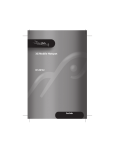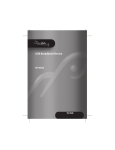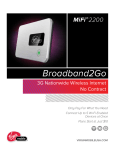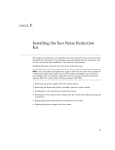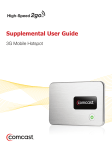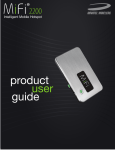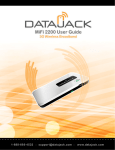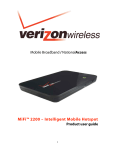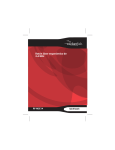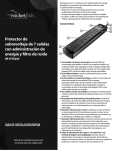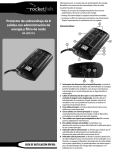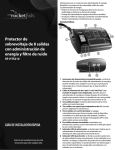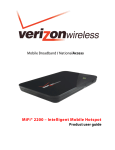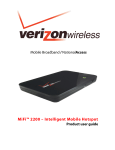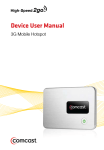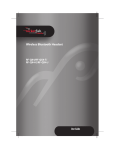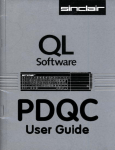Download 3G Personal Mobile Hotspot
Transcript
3G Personal Mobile Hotspot Comprehensive User Guide ©2011 Novatel Wireless, Inc. All rights reserved. The information contained in this document is subject to change without notice and should not be construed as a commitment by Novatel Wireless, Inc. Patents and Licenses Visit www.novatelwireless.com/patents for a complete list of all Novatel Wireless patents. Software License Proprietary Rights Provisions: The software drivers provided with this product are copyrighted by Novatel Wireless and/or Novatel Wireless’ suppliers. Although copyrighted, the software drivers are unpublished and embody valuable trade secrets proprietary to Novatel Wireless and/or Novatel Wireless’ suppliers. The disassembly, decompilation, and/or Reverse Engineering of the software drivers for any purpose is strictly prohibited by international law. The copying of the software drivers, except for a reasonable number of back-up copies is strictly prohibited by international law. It is forbidden by international law to provide access to the software drivers to any person for any purpose other than processing the internal data for the intended use of the software drivers. U.S. Government Restricted Rights Clause: The software drivers are classified as “Commercial Computing device Software” and the U.S. Government is acquiring only “Restricted Rights” in the software drivers and their Documentation. U.S. Government Export Administration Act Compliance Clause: It is forbidden by US law to export, license or otherwise transfer the software drivers or Derivative Works to any country where such transfer is prohibited by the United States Export Administration Act, or any successor legislation, or in violation of the laws of any other country. Trademarks and Service Marks Novatel Wireless is a trademark of Novatel Wireless, Inc., and the other trademarks, logos, and service marks (collectively the “Trademarks”) used in this user manual are the property of Novatel Wireless or their respective owners. Nothing contained in this user manual should be construed as granting by implication, estoppel, or otherwise, a license or right of use of Novatel Wireless or any other Trademark displayed in this user manual without the written permission of Novatel Wireless or its respective owners. • Novatel Wireless, and the Novatel Wireless logo are all trademarks of Novatel Wireless, Inc. • MiFi® and the MiFi logo are registered trademarks of Novatel Wireless, Inc. • Microsoft and Windows are either registered trademarks or trademarks of Microsoft Corporation in the United States and/or other countries. • Apple®, Mac®, and Mac OS® are trademarks of Apple, Inc., registered in the U.S. and other countries. • Linux® is the registered trademark of Linus Torvalds in the U.S. and other countries. • ROCKETFISH™ is a trademark of Best Buy Enterprise Services, Inc. • Best Buy ConnectSM is a registered service mark of Best Buy Connect, LLC. The names of actual companies and products mentioned in this user manual may be the trademarks of their respective owners. Best Buy Connect Mobile Hotspot (MiFi® RF-MFH2) FCC ID: PKRNVWMIFI2200 PN: 90026243_R1 Please visit www.RocketfishProducts.com for the latest information about your device. Contents Product Overview. . . . . . . . . . . . . . . . . . . . . . . . . . . . . . . . . . . . . . . . . . . . . . . . . . . . . . . . 1 Device Overview . . . . . . . . . . . . . . . . . . . . . . . . . . . . . . . . . . . . . . . . . . . . . . . . . . . . . . . . . . . . . . . . . . . . . . . . . . . . . Features. . . . . . . . . . . . . . . . . . . . . . . . . . . . . . . . . . . . . . . . . . . . . . . . . . . . . . . . . . . . . . . . . . . . . . . . . . . . . . . . . . Package Contents . . . . . . . . . . . . . . . . . . . . . . . . . . . . . . . . . . . . . . . . . . . . . . . . . . . . . . . . . . . . . . . . . . . . . . . . System Requirements. . . . . . . . . . . . . . . . . . . . . . . . . . . . . . . . . . . . . . . . . . . . . . . . . . . . . . . . . . . . . . . . . . . . Your Mobile Hotspot. . . . . . . . . . . . . . . . . . . . . . . . . . . . . . . . . . . . . . . . . . . . . . . . . . . . . . . . . . . . . . . . . . . . . . . . . . LED States . . . . . . . . . . . . . . . . . . . . . . . . . . . . . . . . . . . . . . . . . . . . . . . . . . . . . . . . . . . . . . . . . . . . . . . . . . . . . . . Service Status LED. . . . . . . . . . . . . . . . . . . . . . . . . . . . . . . . . . . . . . . . . . . . . . . . . . . . . . . . . . . . . . . . . . . . Power Button LED . . . . . . . . . . . . . . . . . . . . . . . . . . . . . . . . . . . . . . . . . . . . . . . . . . . . . . . . . . . . . . . . . . . . Caring for Your Device. . . . . . . . . . . . . . . . . . . . . . . . . . . . . . . . . . . . . . . . . . . . . . . . . . . . . . . . . . . . . . . . . . . . 2 2 3 3 4 5 5 5 5 Using Your Device. . . . . . . . . . . . . . . . . . . . . . . . . . . . . . . . . . . . . . . . . . . . . . . . . . . . . . . . 6 Using Your Device for the First Time. . . . . . . . . . . . . . . . . . . . . . . . . . . . . . . . . . . . . . . . . . . . . . . . . . . . . . . . . . . 7 Removing the Tab and Charging the Battery . . . . . . . . . . . . . . . . . . . . . . . . . . . . . . . . . . . . . . . . . . . . . . 7 Powering the Device On and Off . . . . . . . . . . . . . . . . . . . . . . . . . . . . . . . . . . . . . . . . . . . . . . . . . . . . . . . . . . 8 Connecting to Your Computer with Wi-Fi. . . . . . . . . . . . . . . . . . . . . . . . . . . . . . . . . . . . . . . . . . . . . . . . . . 8 Activating Your Device . . . . . . . . . . . . . . . . . . . . . . . . . . . . . . . . . . . . . . . . . . . . . . . . . . . . . . . . . . . . . . . . . . . 9 Connecting to MiFi Device Settings for the First Time . . . . . . . . . . . . . . . . . . . . . . . . . . . . . . . . . . . . . 10 Power Management. . . . . . . . . . . . . . . . . . . . . . . . . . . . . . . . . . . . . . . . . . . . . . . . . . . . . . . . . . . . . . . . . . . . . . . . . 11 Inserting the Battery. . . . . . . . . . . . . . . . . . . . . . . . . . . . . . . . . . . . . . . . . . . . . . . . . . . . . . . . . . . . . . . . . . . . . 11 Removing the Battery. . . . . . . . . . . . . . . . . . . . . . . . . . . . . . . . . . . . . . . . . . . . . . . . . . . . . . . . . . . . . . . . . . . 12 Battery Tips. . . . . . . . . . . . . . . . . . . . . . . . . . . . . . . . . . . . . . . . . . . . . . . . . . . . . . . . . . . . . . . . . . . . . . . . . . . . . 12 Accessing the Comprehensive User Guide . . . . . . . . . . . . . . . . . . . . . . . . . . . . . . . . . . . . . . . . . . . . . . . . . . . 13 MiFi Device Settings . . . . . . . . . . . . . . . . . . . . . . . . . . . . . . . . . . . . . . . . . . . . . . . . . . . . 14 MiFi Device Settings Basics. . . . . . . . . . . . . . . . . . . . . . . . . . . . . . . . . . . . . . . . . . . . . . . . . . . . . . . . . . . . . . . . . . Open MiFi Device Settings. . . . . . . . . . . . . . . . . . . . . . . . . . . . . . . . . . . . . . . . . . . . . . . . . . . . . . . . . . . . . . . The Home Page . . . . . . . . . . . . . . . . . . . . . . . . . . . . . . . . . . . . . . . . . . . . . . . . . . . . . . . . . . . . . . . . . . . . . . . . . . . . . The Menu Bar . . . . . . . . . . . . . . . . . . . . . . . . . . . . . . . . . . . . . . . . . . . . . . . . . . . . . . . . . . . . . . . . . . . . . . . . . . . Internet Connection. . . . . . . . . . . . . . . . . . . . . . . . . . . . . . . . . . . . . . . . . . . . . . . . . . . . . . . . . . . . . . . . . . . . . Wi-Fi. . . . . . . . . . . . . . . . . . . . . . . . . . . . . . . . . . . . . . . . . . . . . . . . . . . . . . . . . . . . . . . . . . . . . . . . . . . . . . . . . . . . GPS Local Search . . . . . . . . . . . . . . . . . . . . . . . . . . . . . . . . . . . . . . . . . . . . . . . . . . . . . . . . . . . . . . . . . . . . . . . . Data Meter. . . . . . . . . . . . . . . . . . . . . . . . . . . . . . . . . . . . . . . . . . . . . . . . . . . . . . . . . . . . . . . . . . . . . . . . . . . . . . GPS. . . . . . . . . . . . . . . . . . . . . . . . . . . . . . . . . . . . . . . . . . . . . . . . . . . . . . . . . . . . . . . . . . . . . . . . . . . . . . . . . . . . . . . . . GPS Status. . . . . . . . . . . . . . . . . . . . . . . . . . . . . . . . . . . . . . . . . . . . . . . . . . . . . . . . . . . . . . . . . . . . . . . . . . . . . . GPS Configuration . . . . . . . . . . . . . . . . . . . . . . . . . . . . . . . . . . . . . . . . . . . . . . . . . . . . . . . . . . . . . . . . . . . . . . GPS Local Search . . . . . . . . . . . . . . . . . . . . . . . . . . . . . . . . . . . . . . . . . . . . . . . . . . . . . . . . . . . . . . . . . . . . . . . . Password Settings. . . . . . . . . . . . . . . . . . . . . . . . . . . . . . . . . . . . . . . . . . . . . . . . . . . . . . . . . . . . . . . . . . . . . . . . . . . Create a New Administrative Password . . . . . . . . . . . . . . . . . . . . . . . . . . . . . . . . . . . . . . . . . . . . . . . . . . Wi-Fi Menu . . . . . . . . . . . . . . . . . . . . . . . . . . . . . . . . . . . . . . . . . . . . . . . . . . . . . . . . . . . . . . . . . . . . . . . . . . . . . . . . . Wi-Fi Profile . . . . . . . . . . . . . . . . . . . . . . . . . . . . . . . . . . . . . . . . . . . . . . . . . . . . . . . . . . . . . . . . . . . . . . . . . . . . . 15 15 16 16 18 19 19 19 20 20 21 21 22 22 23 24 Choosing a Profile . . . . . . . . . . . . . . . . . . . . . . . . . . . . . . . . . . . . . . . . . . . . . . . . . . . . . . . . . . . . . . . . . . . Setting Security . . . . . . . . . . . . . . . . . . . . . . . . . . . . . . . . . . . . . . . . . . . . . . . . . . . . . . . . . . . . . . . . . . . . . Setting Up a Temporary Hotspot . . . . . . . . . . . . . . . . . . . . . . . . . . . . . . . . . . . . . . . . . . . . . . . . . . . . . MAC Filter. . . . . . . . . . . . . . . . . . . . . . . . . . . . . . . . . . . . . . . . . . . . . . . . . . . . . . . . . . . . . . . . . . . . . . . . . . . . . . . Finding the MAC Address. . . . . . . . . . . . . . . . . . . . . . . . . . . . . . . . . . . . . . . . . . . . . . . . . . . . . . . . . . . . Using MAC Filtering. . . . . . . . . . . . . . . . . . . . . . . . . . . . . . . . . . . . . . . . . . . . . . . . . . . . . . . . . . . . . . . . . Status. . . . . . . . . . . . . . . . . . . . . . . . . . . . . . . . . . . . . . . . . . . . . . . . . . . . . . . . . . . . . . . . . . . . . . . . . . . . . . . . . . . Wi-Fi Clients. . . . . . . . . . . . . . . . . . . . . . . . . . . . . . . . . . . . . . . . . . . . . . . . . . . . . . . . . . . . . . . . . . . . . . . . . Wi-Fi Log. . . . . . . . . . . . . . . . . . . . . . . . . . . . . . . . . . . . . . . . . . . . . . . . . . . . . . . . . . . . . . . . . . . . . . . . . . . . Broadband Menu . . . . . . . . . . . . . . . . . . . . . . . . . . . . . . . . . . . . . . . . . . . . . . . . . . . . . . . . . . . . . . . . . . . . . . . . . . . Configuration . . . . . . . . . . . . . . . . . . . . . . . . . . . . . . . . . . . . . . . . . . . . . . . . . . . . . . . . . . . . . . . . . . . . . . . . . . . Diagnostics. . . . . . . . . . . . . . . . . . . . . . . . . . . . . . . . . . . . . . . . . . . . . . . . . . . . . . . . . . . . . . . . . . . . . . . . . . . . . Broadband Connection. . . . . . . . . . . . . . . . . . . . . . . . . . . . . . . . . . . . . . . . . . . . . . . . . . . . . . . . . . . . . . Broadband Modem . . . . . . . . . . . . . . . . . . . . . . . . . . . . . . . . . . . . . . . . . . . . . . . . . . . . . . . . . . . . . . . . . Broadband Event Log . . . . . . . . . . . . . . . . . . . . . . . . . . . . . . . . . . . . . . . . . . . . . . . . . . . . . . . . . . . . . . . Broadband Status . . . . . . . . . . . . . . . . . . . . . . . . . . . . . . . . . . . . . . . . . . . . . . . . . . . . . . . . . . . . . . . . . . . . . . . Internet Connection. . . . . . . . . . . . . . . . . . . . . . . . . . . . . . . . . . . . . . . . . . . . . . . . . . . . . . . . . . . . . . . . . Internet Connection Log. . . . . . . . . . . . . . . . . . . . . . . . . . . . . . . . . . . . . . . . . . . . . . . . . . . . . . . . . . . . . Advanced Menu. . . . . . . . . . . . . . . . . . . . . . . . . . . . . . . . . . . . . . . . . . . . . . . . . . . . . . . . . . . . . . . . . . . . . . . . . . . . . Advanced Settings. . . . . . . . . . . . . . . . . . . . . . . . . . . . . . . . . . . . . . . . . . . . . . . . . . . . . . . . . . . . . . . . . . . . . . Access Point. . . . . . . . . . . . . . . . . . . . . . . . . . . . . . . . . . . . . . . . . . . . . . . . . . . . . . . . . . . . . . . . . . . . . . . . . 3G Modem. . . . . . . . . . . . . . . . . . . . . . . . . . . . . . . . . . . . . . . . . . . . . . . . . . . . . . . . . . . . . . . . . . . . . . . . . . Router. . . . . . . . . . . . . . . . . . . . . . . . . . . . . . . . . . . . . . . . . . . . . . . . . . . . . . . . . . . . . . . . . . . . . . . . . . . . . . System. . . . . . . . . . . . . . . . . . . . . . . . . . . . . . . . . . . . . . . . . . . . . . . . . . . . . . . . . . . . . . . . . . . . . . . . . . . . . . Config File. . . . . . . . . . . . . . . . . . . . . . . . . . . . . . . . . . . . . . . . . . . . . . . . . . . . . . . . . . . . . . . . . . . . . . . . . . . . . . Config File Download . . . . . . . . . . . . . . . . . . . . . . . . . . . . . . . . . . . . . . . . . . . . . . . . . . . . . . . . . . . . . . . Config File Upload . . . . . . . . . . . . . . . . . . . . . . . . . . . . . . . . . . . . . . . . . . . . . . . . . . . . . . . . . . . . . . . . . . Port Filtering . . . . . . . . . . . . . . . . . . . . . . . . . . . . . . . . . . . . . . . . . . . . . . . . . . . . . . . . . . . . . . . . . . . . . . . . . . . . Port Filtering for Standard Applications. . . . . . . . . . . . . . . . . . . . . . . . . . . . . . . . . . . . . . . . . . . . . . Port Filtering for Custom Applications . . . . . . . . . . . . . . . . . . . . . . . . . . . . . . . . . . . . . . . . . . . . . . . Port Forwarding. . . . . . . . . . . . . . . . . . . . . . . . . . . . . . . . . . . . . . . . . . . . . . . . . . . . . . . . . . . . . . . . . . . . . . . . . Power Management. . . . . . . . . . . . . . . . . . . . . . . . . . . . . . . . . . . . . . . . . . . . . . . . . . . . . . . . . . . . . . . . . . . . . LED Control . . . . . . . . . . . . . . . . . . . . . . . . . . . . . . . . . . . . . . . . . . . . . . . . . . . . . . . . . . . . . . . . . . . . . . . . . AC Power. . . . . . . . . . . . . . . . . . . . . . . . . . . . . . . . . . . . . . . . . . . . . . . . . . . . . . . . . . . . . . . . . . . . . . . . . . . Battery Power . . . . . . . . . . . . . . . . . . . . . . . . . . . . . . . . . . . . . . . . . . . . . . . . . . . . . . . . . . . . . . . . . . . . . . . TCP/IP. . . . . . . . . . . . . . . . . . . . . . . . . . . . . . . . . . . . . . . . . . . . . . . . . . . . . . . . . . . . . . . . . . . . . . . . . . . . . . . . . . System Status . . . . . . . . . . . . . . . . . . . . . . . . . . . . . . . . . . . . . . . . . . . . . . . . . . . . . . . . . . . . . . . . . . . . . . . . . . . Restarting or Resetting Your Device . . . . . . . . . . . . . . . . . . . . . . . . . . . . . . . . . . . . . . . . . . . . . . . . . . 25 25 26 27 27 28 28 29 30 31 31 32 32 33 33 34 34 35 36 37 37 38 38 39 40 40 40 41 41 42 43 44 44 45 45 46 47 47 Troubleshooting . . . . . . . . . . . . . . . . . . . . . . . . . . . . . . . . . . . . . . . . . . . . . . . . . . . . . . . 48 Overview. . . . . . . . . . . . . . . . . . . . . . . . . . . . . . . . . . . . . . . . . . . . . . . . . . . . . . . . . . . . . . . . . . . . . . . . . . . . . . . . . . . Common Problems and Solutions . . . . . . . . . . . . . . . . . . . . . . . . . . . . . . . . . . . . . . . . . . . . . . . . . . . . . . . . . . . Use the Master Reset Button. . . . . . . . . . . . . . . . . . . . . . . . . . . . . . . . . . . . . . . . . . . . . . . . . . . . . . . . . . . . . . . . . Technical Support. . . . . . . . . . . . . . . . . . . . . . . . . . . . . . . . . . . . . . . . . . . . . . . . . . . . . . . . . . . . . . . . . . . . . . . . . . . 49 50 53 54 Technical Information. . . . . . . . . . . . . . . . . . . . . . . . . . . . . . . . . . . . . . . . . . . . . . . . . . . 55 Product Specifications. . . . . . . . . . . . . . . . . . . . . . . . . . . . . . . . . . . . . . . . . . . . . . . . . . . . . . . . . . . . . . . . . . . . . . . Regulatory Notices . . . . . . . . . . . . . . . . . . . . . . . . . . . . . . . . . . . . . . . . . . . . . . . . . . . . . . . . . . . . . . . . . . . . . . . . . . Safety Hazards. . . . . . . . . . . . . . . . . . . . . . . . . . . . . . . . . . . . . . . . . . . . . . . . . . . . . . . . . . . . . . . . . . . . . . . . . . . . . . SAR Levels. . . . . . . . . . . . . . . . . . . . . . . . . . . . . . . . . . . . . . . . . . . . . . . . . . . . . . . . . . . . . . . . . . . . . . . . . . . . . . Limited Warranty and Liability . . . . . . . . . . . . . . . . . . . . . . . . . . . . . . . . . . . . . . . . . . . . . . . . . . . . . . . . . . . . . . . 56 57 59 60 61 1 Product Overview Device Overview Your Mobile Hotspot Device Overview Thank you for choosing a Best Buy Connect Mobile Hotspot (MiFi® RF-MFH2) device for Mobile Broadband and Wi-Fi! This device operates over high-speed Mobile Broadband networks in the 800/1900 bands enabling you to connect at high speeds to the Internet and your corporate Intranet with up to five Wi-Fi enabled devices from anywhere! Your device is an intelligent Mobile Hotspot, empowering you with high-speed data access on your wireless data network and Wi-Fi connectivity. Features With the Mobile Hotspot, you can: •• Connect to High-Speed Wireless Data •• Benefit from Simultaneous Wi-Fi Connectivity •• With the Mobile Hotspot, connect with Wi-Fi and access high‑speed mobile broadband service to browse the Internet, access email, run business applications and more from a computer or most Wi-Fi-compatible devices. •• The Mobile Hotspot enables multiple Wi-Fi-enabled devices to connect at one time, such as notebooks, desktops, tablet computers, personal digital assistants, and most Wi-Fi enabled consumer devices. •• Typical battery usage time is up to 4 hours active and up to 40 hours standby (with one Wi-Fi connected device). •• Manage Wireless Network Activity – MiFi Device Settings MiFi Device Settings allows you to manage, monitor, and customize your Wi-Fi Mobile Broadband connection through an easy-to-use interface. Additional features include: •• Advanced embedded antenna design for Mobile Broadband and Wi-Fi •• VPN passthrough capability •• Auto installation and connectivity options •• GPS technology to search for stores, restaurants, and other locations in your area 2 Package Contents The Best Buy Connect Mobile Hotspot package includes: •• Mobile Hotspot Device •• AC Wall Charger •• Lithium Ion Battery •• Quick Setup Guide •• User Guide •• Comprehensive User Guide [See Accessing the Comprehensive User Guide on page 17.] System Requirements •• Internet browser (for example, Internet Explorer, Safari, Firefox, Opera, Chrome) •• Wireless interface (802.11b/g) 3 Your Mobile Hotspot Your device has the following parts: ➊➊ Power Button / LED: Powers the device on and off. The LED indicates power, battery status, and roaming activity. ➋➋ ➌➌ Micro USB Connector: The AC charger connects here. ➍➍ Master Reset Button: Resets the device to factory default settings. See Use the Master Reset Button on page 57. ➎➎ ➏➏ Battery Compartment: The battery is placed here. Service Status LED: Provides information about your mobile broadband connection. Network Name and Password Label (Not shown): The preconfigured network name (SSID) and your network key are printed on the back of your device. 4 LED States The device LEDs provide valuable information about the state of the device and connection. Service Status LED LED Color Status No Light Green Description — Solid Slow Blinking Intermittent Blinking The device is powered off. The device is powered on and connected to a mobile broadband network, but is not transmitting or receiving data. The device is powered on but there is no service. The device is transmitting / receiving mobile broadband data. The blinking rate is proportional to the data speed. Power Button LED Led Color Status No Light Green Description — The device is powered off. Solid The device is powered on and fully charged. Glowing Red Blinking The device is in standby mode (power saving). Press the power button to wake up the device. The battery is critically low. Amber Solid The battery is charging. Blue Blinking Solid Error. See Troubleshooting on page 52. The device is powered on and roaming. Caring for Your Device As with any electronic device, the device must be handled with care to ensure reliable operation. Novatel Wireless recommends the following handling guidelines: •• Do not apply adhesive labels to the device; they may cause the device to potentially overheat and they may alter the performance of the antenna system. •• The USB connector should plug easily into your computer’s Type A USB port. Forcing the device into a port may damage the connector. •• Protect the device from liquids, dust, and excessive heat. •• Store the device in a safe place when not in use. 5 2 Using Your Device Using Your Device for the First Time Power Management Accessing the Comprehensive User Guide Using Your Device for the First Time IMPORTANT The device requires an activated account with a network operator to function. Removing the Tab and Charging the Battery NOTE The battery should be fully charged for four hours before using the device for the first time. ➊➊ Turn the device over to show the bottom panel. Notice a plastic tab sticking out from under the battery compartment panel. ➋➋ Pull the plastic tab out in the direction of the arrow. ➌➌ ➍➍ Connect the micro USB end of the AC wall charger to the micro USB port on the device. Plug the other end of the AC wall charger into an appropriate electrical outlet. Charge for at least two and a half hours (four hours recommended). CAUTION! Use only an approved charging accessory to charge your device. Use of an incompatible charger may cause damage to your device and void the warranty. 7 Powering the Device On and Off To power the device on: ➤➤ Press the Power button until the Power LED lights up solid green. To power the device off: ➤➤ Press and hold the Power button until the Power LED shuts off. Connecting to Your Computer with Wi-Fi Tip! The default network name (SSID) for your device is Best Buy Connect xxxx Secure. Your SSID and 11-digit Network Key are printed on the back of your device. (The ‘xxxx’ are the last four characters of your device’s MAC address.) ➊➊ ➋➋ Power on your device. ➌➌ ➍➍ Click Connect. Use your computer’s Wi-Fi manager (Windows) or the AirPort icon (Mac) to select the Best Buy Connect xxxx Secure network name (SSID). Enter the 11-digit network key when prompted for a network key. Tip! The steps to connect to a Wi-Fi network vary depending on your operating system and whether you use the native application or third-party software. Generally you click an icon (often in the Windows notification area or the AirPort icon on a Mac) where you can select “View Available Wireless Networks.” If you are unfamiliar with wireless networking on your computer, consult the computer Help system. 8 Activating Your Device The first time you connect to your mobile hotspot, the activation wizard helps you activate your device, create your account, and set up billing. ➊➊ During the activation process, you need to create your account and set up the billing. Have your personal information (name, credit card number, billing address, email address, etc) ready before you start the activation wizard. ➋➋ From your computer’s Web browser, enter http://bestbuyconnect.mifi (alternatively, http://192.168.1.1) into the address window and then press the Enter or Return key. The Activation window opens. ➌➌ Click the appropriate link for your operating system. The Activation Manager program downloads from the Mobile Hotspot device to your computer. You need to install and run the program, then enter your information to create your account and activate your Mobile Hotspot device. IMPORTANT Be sure to keep the browser window open. The Activation Manager needs it to complete the activation. 9 Immediately after activation is finished, the Mobile Hotspot device restarts and the Activation Successful window opens. ➍➍ Click Continue. 10 ➎➎ Type the login password in the Login password field to start the Setup Wizard. The default Login password is admin. ➏➏ After entering the default login password, click Login. NOTE If you closed your browser window during activation and activation was successful, re-connect to the http://bestbuyconnect.mifi address and you should see the Activation Successful window. 11 For extra security, assign a new password to the device. Enter the new password (4 - 64 characters) into the New Password and Verify New Password fields. ➐➐ Click Next. 12 Use the WiFi Settings screen to setup or change Wi-Fi security settings such as the SSID name, security encryption method and network key. You can also change these settings in the Wi-Fi Profile page (see Wi-Fi Menu on page 27). ➑➑ Click Next after you have finished setting up or changing WiFi security parameters. 13 ➒➒ Click Finish to complete the Mobile Hotspot Setup Wizard. Connecting to MiFi Device Settings for the First Time The Mobile Hotspot has an on-device website, MiFi Device Settings, you can use to change the settings and customize your device. You must activate your device before you can log on to MiFi Device Settings. ➊➊ The Setup Wizard should leave you on the Home Page. If you canceled the Setup Wizard or closed your browser, you can enter http://bestbuyconnect.mifi (alternatively, http://192.168.1.1) in your browser’s address window and then press the Enter or Return key to get to the Home Page. ➋➋ Enter the administrative password (the default password is admin) when requested. You can find out more in the MiFi Device Settings Chapter. See MiFi Device Settings on page 18. 14 Power Management Your device works from its battery or when plugged into a power source. •• Battery — The battery lasts for up to four hours. Charge the battery by plugging in the AC adapter. While the battery is charging the Power Button LED is solid amber. When the battery is fully charged, it is solid green. •• AC Wall charger — Use the device while it is plugged into a wall socket. The battery charges while the device is plugged in. •• USB power from a computer — The battery charges while the device is plugged in. Charging the battery through a computer’s USB port is slower than charging it with the wall charger. NOTE You cannot use Wi-Fi while the device is plugged into a computer’s USB port. Inserting the Battery ➊➊ ➋➋ Place your device on a flat surface with the battery door side up. ➌➌ Place each thumb on the triangle-shaped traction bars near the corners of the device battery door. ➍➍ ➎➎ ➏➏ ➐➐ ➑➑ Using normal thumb pressure on the traction bars, slide the battery door away from you. Hold the device in both hands with the non-battery compartment end of your device near the palms of your hands. The door should move approximately 0.6 cm (1/4 inch) before it clicks and stops moving. Remove the door by picking up the edge of the battery door that moved over your fingers. Insert the battery, lining up the contact points. Replace the door. 15 Removing the Battery WARNING! Never use tools, knives, keys, pens, or any type of object to force the door open or to remove the battery. Using any of these types of objects could result in puncturing the device’s battery. ➊➊ ➋➋ Place your device on a flat surface with the battery door side up. ➌➌ Place each thumb on the triangle-shaped traction bars near the corners of the device battery door. ➍➍ ➎➎ ➏➏ ➐➐ ➑➑ Using normal thumb pressure on the traction bars, slide the battery door away from you. Hold the device in both hands with the label end of your device near the palms of your hands. The door should move approximately 0.6 cm (1/4 inch) before it clicks and stops moving. Remove the door by picking up the edge of the battery door that moved over your fingers. Pull the battery up slightly so that it will move over the edge of your device. Slide the battery out of the battery well. Battery Tips WARNING! To avoid risk of explosion, never dispose of batteries in a fire. •• Battery life depends on the network, signal strength, temperature, features, and accessories used. •• Always use Novatel Wireless original batteries and chargers. The warranty does not cover damage caused by non-Novatel Wireless batteries and/or chargers. •• New batteries or batteries stored for a long time may take more time to charge. •• When charging your battery, keep it near room temperature. •• When storing your battery, keep it uncharged in a cool, dark, dry place. •• Never expose batteries to temperatures below -10o C (14o F) or above 45o C (113o F). Never leave the device in an unattended vehicle since temperatures may be outside the temperature range for this device. •• It is normal for batteries to gradually wear down and require longer charging times. If you notice a change in your battery life, it is probably time to purchase a new battery. •• Some batteries perform best after several full charge/discharge cycles. Before using the device, read the battery safety information in the “Safety Hazards” section of this guide. See Proper Battery Use and Disposal on page 64. 16 Accessing the Comprehensive User Guide You can access this User Guide through a link in MiFi Device Settings. You can also find it online at www.RocketfishProducts.com. To Access the Comprehensive User Guide: ➊➊ Connect to MiFi Device Settings. Open your Web browser and enter http://bestbuyconnect. mifi (alternatively, http://192.168.1.1) into the address window. ➋➋ At the top of the page, click the link to download the comprehensive user guide. The Comprehensive User Guide explains the device’s hardware features and Wi-Fi configuration. 17 3 MiFi Device Settings MiFi Device Settings Basics The Home Page GPS Password Settings Wi-Fi Menu Broadband Menu Advanced Menu MiFi Device Settings Basics Open MiFi Device Settings ➊➊ Open your Web browser and enter http://bestbuyconnect.mifi (alternatively, http://192.168.1.1) into the address window. ➋➋ Type the administrative password (the default password is admin) into the Login box in the upper right corner and then click Login. The Home page opens. See The Home Page on page 20. 19 The Home Page The Home page is the first screen you see after logging in to the browser interface. It is the main point of entry for all your work in the browser interface. The Menu Bar The menu bar runs horizontally along the top of the MiFi Device Settings interface. Besides allowing you to select menu items, the menu bar also displays information about your device’s connection strength and battery level. 20 The Home page is divided into sections you can expand or collapse. Click the solid black pointer next to the section title to expand or collapse that section. 21 Internet Connection The Internet Connection section tells you: •• Your connection status. •• Whether or not your device is roaming on another carrier’s network. •• The number of bytes received and transmitted. •• The duration of the current connection. •• The IP address of and subnet mask for your device. •• The address of Gateway and Domain Name Server (DNS) to which you are connected. Connect / Disconnect Button Click Connect to connect to the network. The button label changes to Disconnect. Click Disconnect to disconnect from the network. Setup Wizard Button Click Setup Wizard to change the administrative password or your Wi-Fi security settings without needing to navigate through the menus. 22 Wi-Fi The Wi-Fi section tells you: •• The profile currently in use. •• The network name (also known as the SSID). •• The security method in use. •• The number of users currently connected to your device. •• The IP address of and subnet mask for the wireless interface. To change Wi-Fi settings, use the Wi-Fi menu. See Wi-Fi Menu on page 27. GPS Local Search See GPS Local Search on page 25. Data Meter The Data Meter tracks the amount of data you have used. This is a separate program you can install on your computer. If you use the device with more than one computer, you can click the appropriate link to re-download the software to the other computer. IMPORTANT Although the Data Meter shows the amount of data used for individual sessions or individual devices, billing is measured by the total amount of data used by the account for the total number of devices. Go to www.RocketfishProducts.com for account status, customer service, and support. 23 GPS GPS settings allow you to enable and configure GPS searching for your device. The GPS page is divided into sections. You can expand or collapse each section by clicking the solid black pointer next to each section. GPS Status Once a location fix has been made, the GPS Status section of the GPS page gives you the following information: •• GPS Status — The status of the GPS, including, but not limited to, Searching and Acquired. •• Last fix — The date and time of the last GPS fix. •• Horizontal accuracy — A measure of how close an estimate of a GPS position is to the true location. •• Latitude — The measure of the angular distance between a location on earth and that location north or south of the equator. •• Longitude — The measure of the angular distance between a location on earth and that location’s meridian from the Prime (Greenwich) Meridian. •• Altitude — The distance measurement, usually in the vertical or “up” direction, between a reference point and a specified point or object. 24 GPS Configuration Use this section to configure the GPS settings. ➊➊ ➋➋ ➌➌ ➍➍ Select the Enable GPS check box to turn on GPS. In the Search provider list, select a search provider. Click Yes to accept the GPS privacy agreement. Click Apply to confirm the settings. GPS Local Search Once the GPS status changes from “Searching” to “Acquired,” you can search for restaurants, banks, hotels, gas stations, coffee shops or a specific address. ➤➤ Click the button next to the type of business you want to search for. – OR – ➤➤ Type a business name or an address in the search box and then click Search. Tip! If the GPS status does not change to Acquired, try moving the device close to a window or outdoors. 25 Password Settings Password settings allow you to change the administrative password that gives access to the browser interface. IMPORTANT Record your administrative password. If you forget it, you have to reset your device before you can use the MiFi Device Settings interface again. Create a New Administrative Password ➊➊ ➋➋ Type your current password in the Current Password box. ➌➌ Click Apply. Type the new password (must have 4 to 64 characters) in the New Password box and then again in the Verify New Password box. 26 Wi-Fi Menu The Wi-Fi menu allows you to work with profiles, set up a temporary hotspot, set MAC filters, and view status information for the Wi-Fi network. The Wi-Fi menu is divided into sections: •• Wi-Fi Profile — View or change settings for your secure profile or set up a temporary hotspot. •• MAC Filter — Allow only certain devices to connect to your device. •• Status — View profile information, see who is connected to your device, and view the Wi-Fi log. You can also retrieve your network key from this page. 27 Wi-Fi Profile Click Wi-Fi Profile on the Wi-Fi menu to configure your secure profile or set up a temporary hotspot. The Wi-Fi Profile page displays the following information: •• Profile — The profile currently being used. See Choosing a Profile on page 29. •• Network Name (SSID) — Name of the network you are connected to. You can change the name to something more descriptive if you want to. You might want to change the network name if other similar devices are in use within range of yours. Some examples of network names are: •• Secure — Best Buy Connect xxxx Secure •• Open — Best Buy Connect xxxx •• Temporary Hotspot — Best Buy Connect xxxx Temp •• 802.11 Mode — The type of wireless networking you are currently using. The available modes are: •• 802.11g+802.11b •• 802.11g •• 802.11b •• Channel — The radio channel that the device is using. This should be usually set to Auto (default) and left unchanged. Available channels are 1 through 11. •• Security — The type of security the profile is using. This applies to the secure and the temporary hotspot profiles. See Setting Security on page 29. •• Authentication — Locked to Open Access for all profiles. •• Encryption — Displays the type of encryption for the security type in use. 28 •• Network Key — Passcode or password used to access the network. Your operating system might refer to this as the Wi-Fi Key, Wi-Fi Password, WEP Key, WEP Password, or similar. The required format varies by the security type. Choosing a Profile ➤➤ Select a profile from the Profile list: •• Secure — This is the profile you should use most of the time. You can set up this profile with the security measures you need to use your device safely. •• Temporary Hotspot — This profile allows you to set up a secure temporary hotspot to allow others in your work area (maximum of five) to go online at the same time. •• Open — This profile does not require a password to connect to your device. Any user who can see your network name (SSID) can connect to your device. Setting Security You can use WEP (64- or 128-bit), WPA Personal/PSK, WPA2 Personal PSK, or WPA/WPA2 Mixed Mode security. Tip! Some Wi-Fi clients become confused if the security is changed and the network name is not. If you change security settings and do not get asked for the new network key when you try to reconnect, delete the existing “old” network name from your “Preferred Networks” list. Then you can reconnect using the new network name. IMPORTANT Record your network key. ➊➊ ➋➋ From the Wi-Fi Profile page, select Secure as the Profile. ➌➌ Enter a new network key in the Network Key box. (Permissible characters are listed in gray just under the box.) ➍➍ Click Apply. Your device restarts, and you must reconnect to your wireless network using the new network key. Select a security protocol from the Security list. (The Encryption box displays the corresponding encryption level.) 29 Setting Up a Temporary Hotspot You can use this profile to create a secure temporary hotspot to allow a maximum of five connections to your device at one time. This profile generates a temporary network name and network key that you can use to allow others to connect to your device without your having to change the security settings on your secure profile. To set up the temporary hotspot. ➊➊ From the Wi-Fi Profile page, select Temporary Hotspot as the profile. You see a new (temporary) network name (SSID) and network key. In the example shown above, the temporary network name is Best Buy Connect xxxx Secure. ➋➋ Click Apply. Your device restarts, and you must reconnect to your wireless network with the temporary network name and network key. Members of your workgroup can now use the temporary network name and network key to connect to your device. Tip! Click Generate new values to create a new network name and network key. When you are finished sharing your Internet connection, you should change the profile setting back to your normal “Secure” profile. 30 MAC Filter MAC filtering allows you to limit access to your device to only those devices with a specified MAC address (a unique code assigned to hardware such as network adapters). The MAC Filter page allows you to enable or disable MAC filtering and to add or delete MAC addresses from the trusted client list. IMPORTANT Do not enable MAC filtering unless you have added your own MAC address to the trusted client list. Otherwise you will be unable to access your device. Finding the MAC Address The MAC Address is also known as a hardware or physical address for a device, usually a network adapter. It consists of six pairs of numbers and letters (for example, 00-21-9B-1C-64-34). You can view the MAC address for any device connected to your device in the Wi-Fi Clients section of the Wi-Fi Status page. See Wi-Fi Clients on page 33. •• On a Windows PC, you can find the MAC address by typing ipconfig /all in the Command Prompt window. The MAC address is referred to as the Physical Address. (Select Start > All Programs (or Programs) > Accessories > Command Prompt to open the Command Prompt window.) •• On a Mac computer, click the Apple () icon > System Preferences > Network. Select AirPort, then click the Advanced button. The Airport ID is the MAC address. IMPORTANT Make sure you get the MAC address for the wireless network adapter and not the Ethernet controller (NIC) if the computer has both. 31 Using MAC Filtering ➊➊ From the MAC Filter page, type the MAC address for your computer into the Add Trusted Client MAC Address box and click Add Client. You can use either “:” or “-” as the separator (for example, 00:21:9B:1C:64:34 or 00-21-9B-1C-64-34). Tip! You can cut-and-paste your computer’s address from the Wi-Fi Clients section of the Wi-Fi Status page. [See “Wi-Fi Clients” (page 33).] ➋➋ If desired, type the MAC address for other computers into the Add Trusted Client MAC Address box and click Add Client. ➌➌ Select the Enable MAC Filter check box and click Apply. Status Wi-Fi Status provides you with information about your wireless network. The Wi-Fi Status page is divided into sections. 32 Wi-Fi Network The Wi-Fi Network section of the Wi-Fi Status page shows the following information: •• Profile currently in use. •• Network Name (SSID) for your device. •• Number of clients currently connected. •• Maximum number of clients allowed to connect to your device. You can select the maximum number of connections in the Clients Allowed menu. •• Channel being used. •• Current wireless mode. •• Security type and encryption for the current profile. •• Network Key link. (Click to retrieve the network key.) Wi-Fi Clients The Wi-Fi Clients section of the Wi-Fi Status page shows the computers or other devices that are currently connected to your device. This is another way you can find the MAC address for a particular device. 33 Wi-Fi Log ➤➤ Click the Wi-Fi Log button to view a listing of Wi-Fi events (most recent first). 34 Broadband Menu The Broadband menu allows you to update your Preferred Roaming List (PRL), displays information about your network connection, and provides tools for technical support. The Broadband Menu has three components: •• Configuration — Update your PRL or update the device firmware. •• Diagnostics — View the status of your connection to the network, view information about your device, or view an event log about your connections to the network. •• Status — View information about your internet connection, view traffic counters, or view an Internet connection log. Configuration Click Configuration in the Broadband menu to update your PRL or update the device firmware. Select from the following options on the Broadband Configuration page: ➤➤ Click Update PRL to update your provider’s Preferred Roaming List. Tip! You should update your PRL about every three months to make sure you have the latest enhancements. ➤➤ Click Update Firmware to update your device’s internal software (firmware). WARNING If technical support instructs you to upgrade the firmware, be very careful not to turn off the device while the upgrade is in progress. It can take several minutes to contact the server and complete the update after the device power cycles. Do not turn the unit off for at least five minutes after the power cycle. 35 Diagnostics Click Diagnostics in the Broadband menu to access status information about your Internet connection and device. The Broadband Diagnostic page is divided into sections. Broadband Connection The Broadband Connection section displays the following information: •• Connection status: •• Active — connected and transmitting data •• Dormant — connected but not transmitting data •• Disconnected — not connected to the network •• Type of network (technology) you are connected to. •• Roaming status. IMPORTANT Do not click Manual Device Setup unless you have received an MSL number from technical support. 36 Broadband Modem The Broadband Modem section displays the following information: •• Manufacturer — manufacturer of your device. •• Model — model name or number of your device. •• Firmware version — current internal software (firmware) version. •• ESN — unique number the network uses to identify your device. •• MDN — public ID for your specific wireless service. •• MSID — internal ID your network uses to identify your account. •• NAI — address of your device on the network. •• PRL Version — use to verify that your PRL (preferred roaming list) is the most current. IMPORTANT Do not click Reset Modem unless you have received an MSL number from technical support. Reset Modem clears your network account information and requires reactivation of your device. Broadband Event Log The Broadband Event Log section lists network connection events and times when they occurred. Technical support uses the log as a troubleshooting tool. 37 Broadband Status The Broadband Status page shows information about your internet connection. The Broadband Status page is divided into sections. Internet Connection The Internet Connection section displays the following information: •• Your connection status. •• Whether or not your device is roaming on another carrier’s network. •• The number of bytes received and transmitted. •• The duration of the current connection. •• The IP address of and subnet mask for your device. •• The address of Gateway and Domain Name Server (DNS) to which you are connected. ➤➤ Click Disconnect to leave the network or Connect to rejoin the network. 38 Internet Connection Log Click Internet Connection Log to open a log of outgoing traffic showing these details: •• Date/Time •• Client IP Address (IP address of sender) •• Destination (IP address of recipient) •• Port (computer port through which data was sent) •• Type (connection protocol used) 39 Advanced Menu The Advanced menu allows you to back up and restore your configuration, specify router settings such as DHCP, port filtering, and port forwarding, and to customize power management settings. The Advanced menu has seven components: •• Advanced Options — Enable SSID broadcast, auto-connect to the network, DHCP, VPN passthrough, or view the system log. •• Config File — Back up or restore a file containing your device settings. •• Port Filtering — Specify which applications can access the Internet and through which port(s). •• Port Forwarding — Specify which applications can access your computer through the Internet and through which port(s). You might use this if you have an FTP server on your system or play certain online games. •• Power Management — Customize your device’s power-saving settings. •• TCP/IP — View or change the IP address and subnet mask for your device, and to view the MAC address and DHCP address range for your device. •• System Status — View information about your device and to view the system log. You can also restart your device or restore it to its factory default settings. 40 Advanced Settings Click Advanced Options in the Advanced menu to configure your device or to enable the system log. The Advanced Settings page is divided into sections. Access Point Enabling SSID broadcasting allows other nearby computers to see your device’s network name (SSID). This is what you see when you select “View Available Wireless Networks” (Windows) or click the AirPort icon (Mac). Disabling SSID broadcasting provides additional security but you have to re-enable it if you lose your automatic connection. ➤➤ Select the SSID broadcast enable check box to enable SSID broadcasting, or clear the check box to disable SSID broadcasting, and then click Apply. 41 3G Modem Enabling auto-connect allows your device to connect to your network automatically when it is turned on. ➤➤ Select the Auto-connect enable check box to enable auto-connection, or clear the check box to disable auto-connection, and then click Apply. Enabling roaming allows your device to continue working even when off your service provider’s network. Roaming charges may apply. Three options are available: •• Automatic — Allows roaming on other providers’ networks. •• Home network only — Prevents roaming. With either of these options set, you can select the Allow International Access check box to allow roaming on networks outside the United States. ➤➤ Select an option, then click Apply. Router Enabling the DHCP server allows your device to automatically assign a local IP address to a new device joining your network (such as a wireless printer or an additional laptop). When the DHCP server is disabled, you have to assign static IP addresses to all devices on your network. ➤➤ Select the DHCP Server enable check box to enable the DHCP server, or clear the check box to disable the DHCP server, and then click Apply. VPN passthrough is required if you are going to connect to a VPN (such as a corporate system). ➤➤ Select the VPN Passthrough enable check box to enable VPN passthrough, or clear the check box to disable VPN passthrough, and then click Apply. 42 System The System section allows you to select your preferred language, date format, and time format, and to turn on the system log. NOTE You can view the system log. See System Status on page 51. ➊➊ In the Language list, click the language you wish to use. (Currently English is the only option, and this list is disabled (grayed-out). ➋➋ In the Date/Time list, click the date format (U.S. or European) and the time system (12-hr or 24-hr) that you want to use. ➌➌ Confirm your selections and click Apply. 43 Config File Click Config File in the Advanced menu to back up your configuration file (settings) to your computer, or to restore a saved configuration file from your computer. The Config File page is divided into sections and allows you to back up and restore your device configuration settings. Config File Download Back up your settings file to your computer ➊➊ ➋➋ Click Download File. Click Save to place the file “config.xml.savefile” on your computer. You may rename the file. (If the file opens in your browser instead of downloading, use your browser’s File menu to save the file to your computer.) Config File Upload Restore your settings file to the device ➊➊ ➋➋ ➌➌ ➍➍ Click Browse and navigate to the backup file on your computer. Click the file to highlight it and then click Open. Click Upload File. Click OK when the Upload completed message appears. IMPORTANT If your Wi-Fi settings changed since you created the backup file, you may lose your connection after restoring from the backup file. You need to reconnect using your new (changed) settings. 44 Port Filtering Click Port Filtering in the Advanced menu to enhance the security of your system by controlling which applications are allowed to access the Internet. Port filtering allows you to conserve bandwidth by preventing non-business applications from accessing the Internet. It can also be used to specifically allow certain applications such as games and video conferencing software to use certain ports to access their online components. The Port Filtering page allows you to enable port filtering, allow selected applications to access the Internet, and set up custom applications for access to the Internet. Port Filtering for Standard Applications ➊➊ ➋➋ From the Port Filtering page, select the Enable Port Filtering check box. ➌➌ Click Apply. Select the check boxes for the applications for which you want to allow access to the Internet. NOTE The device uses standard ports for these applications. If you have applications that do not use the standard ports or that are not listed under Allowed Applications, use Custom Applications. 45 Port Filtering for Custom Applications To set up port filtering for a custom application, you need to know the port numbers (up to five ports or port ranges) and the protocol (TCP, UDP, or both) the application uses for its outgoing traffic. ➊➊ ➋➋ ➌➌ From the Port Filtering page, select the Enable Port Filtering check box. ➍➍ Enter the port or port range. You can enter up to five ports or port ranges. Click Custom Applications. Enter a name for the application and click the Ports link. •• Single port — enter the port number in both fields. •• Port range — enter the beginning port number in the left field and the ending port number in the right field. ➎➎ For each port number or range, select the protocol (TCP, UDP, or both) used by that port or port range. ➏➏ ➐➐ Click Hide. Click Apply. 46 Port Forwarding Port forwarding allows designated users or applications to reach specified servers, such as FTP and DNS servers, on your computer. Also, some online games require incoming access to work properly. IMPORTANT You need to set up static IP addresses on your WLAN for each device that has an application to which you want to forward. The Port Forwarding page allows you to enter the local static IP address for each application that you want to receive traffic from the Internet. ➊➊ ➋➋ From the Port Forwarding page, select the check box for the application you want to enable. ➌➌ Click Apply when you have finished adding applications. Type the local static IP address of the device hosting the application into the IP Address on WLAN box. IMPORTANT Port forwarding creates a security risk and should be disabled when not needed. 47 Power Management Your device can switch to a low-power mode when it is idle. The Power Management page allows you to set the maximum time before your device switches to low-power mode. You can set separate times for AC power and battery power. When your device is on battery power, you can set the length of time before it shuts down. You can also turn off your device’s LEDs to save additional power. Use the Power Management page to set how long your device is idle before it switches to low‑power mode. The Advanced Settings page is divided into sections. LED Control ➊➊ Select the Disable LEDs check box to disable or clear the check box to enable your device’s LEDs. NOTE The Disable LEDs option turns off all LEDs except for critical errors and low battery. ➋➋ Click Apply. 48 AC Power ➊➊ Select the time that elapses before your device switches to low‑power mode when not in use (2 to 60 minutes), or click Never to disable this feature when on AC power. ➋➋ Click Apply. Battery Power ➊➊ Select the time that elapses before your device switches to low-power mode when not in use (2 to 60 minutes), and the time before your device shuts down (2 to 60 minutes); or click Never to disable either or both of these features when your device is on battery power. ➋➋ Click Apply. 49 TCP/IP The TCP/IP page allows you to view the local (WLAN) IP address and the MAC address for your device. From the Advanced menu, click TCP/IP to display the following information about your device: •• Local IP address •• Subnet mask •• MAC address of your device •• DHCP address range used by your device’s DHCP server The IP address and subnet mask can be changed by entering new numbers and clicking Apply. If you have devices on your network with local static IP addresses, those addresses should not be within the DHCP range. 50 System Status The System Status page allows you to view real-time system information and the system log, and to restart your device or restore it to factory defaults. From the Advanced menu, click System Status to display the following information about your device: •• Manufacturer •• Model •• Serial number •• AP (access point) version •• Router version •• Modem version Restarting or Resetting Your Device In addition to viewing status information, you can restart your device or reset it to factory defaults from the System Status page. ➤➤ Click Restart to re-initialize your device (same as turning it off and on again). – or – ➤➤ Click Reset to Factory Defaults to reset your device Wi-Fi settings to the original state they were in at the time of purchase. IMPORTANT After either step you may lose your connection and have to reconnect, and after clicking Reset to Factory Defaults you need to rerun the startup wizard and reset your security. 51 4 Troubleshooting Overview Common Problems and Solutions Use the Master Reset Button Technical Support Overview The following tips help solve problems that might be encountered while using the device: •• Make sure you are using the device in the correct geographic region. •• Ensure that the wireless network’s coverage extends to your current locations. •• Power the device off and then on again. When properly installed, the device is a highly reliable product. Most problems are caused by one of these issues: •• System resources required by the device are being used by other devices. (Rebooting your computer often clears this up.) •• Network coverage is not available (either because you are outside the coverage area of your network operator or because of an account or network problem). 53 Common Problems and Solutions The following are some common problems and solutions. No service is available. - OR I get a “Limited or No Connectivity” message. ➤➤ You are outside of the coverage area. ➤➤ Check with your network operator — there may be a problem with your account. ➤➤ Reorient the device. ➤➤ If you are inside a building or near a structure that may be blocking the signal, change the position or location of the device. For example, try moving the device close to a window. The device has no power. The LED indicator is off and does not come on when the Power button is pressed. ➤➤ Ensure the battery is properly seated in the device. ➤➤ Ensure the battery is fully charged. Plug in the wall charger for at least 2.5 hours. My device powered off once I plugged it into the wall charger. This can occur if power settings are activated after it is plugged in. ➤➤ Press the power button to turn it back on. My device just powered off without my pressing the power button. This can occur in the following situations. •• Pressing the Master Reset button •• Restarting the device •• Switching profiles •• Restoring the configuration settings •• Battery depleted ➤➤ Press the power button to turn it back on. I forgot my password. ➤➤ You can reset the device to factory default settings using the Master Reset button. See Use the Master Reset Button on page 57. 54 I cannot connect to the device. ➤➤ Be sure the device is not connected to a computer’s USB port. ➊➊ Make sure the LEDs are on. If the LEDs are not on, check the battery. ➋➋ Make sure your computer’s wireless radio (Windows) or AirPort (Mac) is turned on. (Check your computer’s Help system if you need assistance.) ➌➌ Open your wireless network connection list. •• Windows: Right-click the wireless icon and select View Available Networks. •• Mac: Click the AirPort icon. ➍➍ Select the device network name Best Buy Connect xxxx Secure (if Windows, click Connect). When the device is connected to the network, the status LED begins to blink. My network does not appear in the wireless network list. ➤➤ Verify that the device LEDs are on and are not showing an error condition. See LED States on page 5. ➤➤ Refresh your network list. •• Windows: Click Refresh Network List on the left side of the Wireless Network Connection screen. If that does not work you can try the following: 1. 2. 3. 4. 5. Open Network Connections. Right-click Wireless Network Connection and select Properties. Click the Wireless Networks tab. Delete any unused wireless connections from the Preferred Networks list and click OK. Restart your computer. •• Mac: Click the AirPort icon to refresh the list of wireless networks. If that does not work, select Turn AirPort Off, and then click the AirPort icon again and select Turn AirPort On. How do I disconnect from the network? ➤➤ Log in to MiFi Device Settings and click Disconnect. 1. Open your browser and type http://bestbuyconnect.mifi (alternatively, http://192.168.1.1) in the address window. 2. Then type your administrative password in the login window and click Login. 3. Click the Disconnect button. How can I find out how many users are connected to the device? ➤➤ Open MiFi Device Settings; type http://bestbuyconnect.mifi (alternatively, http://192.168.1.1) in a browser window. The number of devices (users) currently connected to the device is in the WLAN section at the bottom of the screen. 55 How can I check the battery level of the device? ➤➤ Open MiFi Device Settings; type http://bestbuyconnect.mifi (alternatively, http://192.168.1.1) in a browser window. The battery status icon is displayed in the menu bar. Can I backup my configuration settings? Yes. You need to download the configuration file. 1. Open MiFi Device Settings; type http://bestbuyconnect.mifi (alternatively, http://192.168.1.1) in a browser window. 2. Log in and choose Advanced>Config File. 3. Click Download File. See Config File on page 44. How do I turn off the device? ➤➤ Press and hold the Power button for five seconds until the LEDs turn off. What is the default administrative password? admin I am having trouble connecting to my office VPN. ➤➤ Open MiFi Device Settings; type http://bestbuyconnect.mifi (alternatively, http://192.168.1.1) in a browser window. Log in and choose Advanced > Settings. Select the VPN Passthrough enable check box and then click Apply. See Advanced Settings on page 41. 56 Use the Master Reset Button The device comes with a Master Reset button that allows you to return it to its factory default state. The Master Reset button is recessed in a hole on the back of the device. You need a paperclip or similar object to push the button. ➊➊ ➋➋ ➌➌ Make sure the device is powered on. Locate the Master Reset button on the back of the device. Insert a paperclip into the hole and hold the button down for 15 seconds until the Power LED is off. Your list of wireless networks now shows the original default network when you first configured your device. ➍➍ Connect to the device again. 57 Technical Support For additional information and technical support, visit www.RocketfishProducts.com. 58 5 Technical Information Product Specifications Regulatory Notices Safety Hazards Limited Warranty and Liability Product Specifications General Name Best Buy Connect Mobile Hotspot (MiFi® RF-MFH2) MiFi® RF-MFH2 COFETEL, NOM, CDG 58 g / 2.05 oz 59 mm x 9 mm x 89 mm CDMA 1X/EV-DO 802.11 b/g Best Buy Connect (the last 4 digits of the MAC address) Secure Model Approvals Weight Dimensions (W x D x H) Broadband Network — Dual Mode Wi-Fi Network Default Network Name (SSID) Battery • Size 1150 mAh • Time to full charge: AC Charger 2.5 hrs (when not in use) • Time to full charge: computer USB cable LED Chip Set Interface Type 7-8 hrs (when not in use) Two: Power and 3G indicators QUALCOMM™ MDM6085 Type A USB Port for computer Micro USB for device (cable not included) CDMA Technology/Bands Technology Band Designation Transmit Band Receive Band CDMA Rev A, Rev 0, 1XRTT 800/1900 MHz 824.7 – 848.31 MHz / 1851.25 – 1908.75 MHz 1851.25 – 1908.75 MHz / 1931.25 – 1988.75 MHz Environmental Operating Temperature Storage Temperature Drop Vibrational Stability -10o C to 45o C (14o F to 113o F) -20o C to 65o C (-4o F to 149o F) 3.28 feet drop, no damage—fully operational 5 Hz to 500 Hz, 0.1 octave/second 60 Regulatory Notices CE Marking This device has been tested to and conforms to the essential regulatory requirements of the European Union R&TTE directive 1999/5/EC and has attained CE Marking. Federal Communications Commission Notice (FCC – United States) This equipment has been tested to, and found to be within the acceptable limits for a Class B digital device, pursuant to part 15 of the FCC Rules and Industry Canada ICES-003. These limits are designed to provide reasonable protection against harmful interference when the equipment is operated in a residential environment. This equipment generates radio frequency energy and is designed for use in accordance with the manufacturer’s user manual. However, there is no guarantee that interference will not occur in any particular installation. If this equipment causes harmful interference to radio or television reception, which can be determined by turning the equipment off and on, you are encouraged to try to correct the interference by one or more of the following measures: •• Reorient or relocate the receiving antenna. •• Increase the separation between the equipment and the receiver. •• Connect the equipment into an outlet on a circuit different from that to which the receiver is connected. •• Consult the dealer or an experienced radio/television technician for help. This device complies with Part 15 of the Federal Communications Commission (FCC) Rules. Operation is subject to the following two conditions: •• This device may not cause harmful interference. •• This device must accept any interference received, including interference that may cause undesired operation. WARNING: DO NOT ATTEMPT TO SERVICE THE WIRELESS COMMUNICATION DEVICE YOURSELF. SUCH ACTION MAY VOID THE WARRANTY. THE MIFI DEVICE IS FACTORY TUNED. NO CUSTOMER CALIBRATION OR TUNING IS REQUIRED. CONTACT NOVATEL WIRELESS TECHNICAL SUPPORT FOR INFORMATION ABOUT SERVICING YOUR WIRELESS COMMUNICATION DEVICE. 61 NOTICE TO CONSUMERS: Any changes or modification not expressly approved by the party responsible for compliance could void the user’s authority to operate this equipment. NOTE: The Radio Frequency (RF) emitter installed in your modem must not be located or operated in conjunction with any other antenna or transmitter, unless specifically authorized by Novatel Wireless Technologies. MODIFICATIONS: The FCC requires that you be notified that any changes or modifications made to this device that are not expressly approved by Novatel Wireless may void your authority to operate the equipment. RF Exposure FCC Equipment Authorization ID: PKRNVWMIFI2200 This device is only authorized for use in Mobile applications. At least 8 inches (20 cm) of separation between the antenna and the user’s body must be maintained at all times. 62 Safety Hazards Do not use your Mobile Hotspot in an environment that may be susceptible to radio interference resulting in danger, specifically: Areas where prohibited by the law Follow any special rules and regulations and obey all signs and notices. Always turn off the Mobile Hotspot when instructed to do so, or when you suspect it might cause interference or danger. Where explosive atmospheres may be present Do not operate your modem in any area where a potentially explosive atmosphere may exist. Sparks in such areas could cause an explosion or fire resulting in bodily injury or even death. Be aware and comply with all signs and instructions. Users are advised not to operate the modem while at a refueling point or service station. Users are reminded to observe restrictions on the use of radio equipment in fuel depots (fuel storage and distribution areas), chemical plants or where blasting operations are in progress. Areas with a potentially explosive atmosphere are often but not always clearly marked. Potential locations can include gas stations, below deck on boats, chemical transfer or storage facilities, vehicles using liquefied petroleum gas (such as propane or butane), areas where the air contains chemicals or particles, such as grain, dust or metal powders, and any other area where you would normally be advised to turn off your vehicle engine. Near medical or life support equipment Do not operate the Mobile Hotspot in any area where medical equipment, life support equipment, or near any equipment that may be susceptible to any form of radio interference. In such areas, the communications device must be turned off. The Mobile Hotspot may transmit signals that could interfere with this equipment. On an aircraft, either on the ground or airborne In addition to FAA requirements, many airline regulations state that you must suspend wireless operations before boarding an airplane. Please ensure the Mobile Hotspot is powered off prior to boarding aircraft in order to comply with these regulations. The Mobile Hotspot can transmit signals that could interfere with various onboard systems and controls. While operating a vehicle The driver or operator of any vehicle should not operate a wireless data device while in control of a vehicle. Doing so detracts from the driver or operator’s control and operation of that vehicle. In some countries, operating such communications devices while in control of a vehicle is an offense. Electrostatic discharge (ESD) Electrical and electronic devices are sensitive to electrostatic discharge (ESD). If the device is not operational after an ESD occurrence, then restart your device. 63 SAR Levels The FCC has granted an Equipment Authorization for this wireless modem with all reported SAR levels evaluated as in compliance with the FCC RF exposure guidelines. Proper Battery Use and Disposal IMPORTANT! In the event of a battery leak: • Do not allow the liquid to come in contact with the skin or the eyes. If contact is made, wash the affected area with large amounts of water and seek medical advice. • Seek medical advice immediately if a battery has been swallowed. • Communicate the appropriate steps to be taken if a hazard occurs. Due to the transmission and reception properties of wireless communications, data occasionally can be lost or delayed. Contact your local recycling center for proper battery disposal. Guidelines for Safe and Responsible Battery Use •• Never dispose of batteries in a fire because they might explode. •• Do not disassemble or open, crush, bend or deform, puncture, or shred. •• Do not modify or remanufacture, attempt to insert foreign object into the battery, immerse or expose to water or other liquids, or expose to fire, explosion, or other hazard. •• Only use the battery for the system for which it was specified. •• Only use the battery with a charging system that has been qualified with the system per this standard. Use of an unqualified battery or charger may present a risk of fire, explosion, leakage, or other hazard. •• Do not short circuit a battery or allow metallic or conductive object to contact the battery terminals. •• Replace the battery only with another battery that has been qualified with the system per this standard. Use of an unqualified battery may present a risk of fire, explosion, leakage, or other hazard. •• Promptly dispose of used batteries in accordance with local regulations. •• Battery usage by children should be supervised. •• Avoid dropping the device or battery. If the device or the battery is dropped, especially on a hard surface, and the user suspects damage, take it to a service center for inspection. •• Improper battery use may result in a fire, explosion, or other hazard. 64 Limited Warranty and Liability Novatel Wireless warrants for the 12 month period immediately following receipt of the Product by Purchaser that the Product will be free from defects in material and workmanship under normal use. THESE WARRANTIES ARE EXPRESSLY IN LIEU OF ALL OTHER WARRANTIES, EXPRESS OR IMPLIED, INCLUDING, WITHOUT LIMITATION, ALL IMPLIED WARRANTIES OF MERCHANTABILITY AND FITNESS FOR A PARTICULAR PURPOSE. The exclusive remedy for a claim under this warranty shall be limited to the repair or replacement, at Novatel Wireless’ option, of defective or non-conforming materials, parts or components. The foregoing warranties do not extend to (I) non conformities, defects or errors in the Products due to accident, abuse, misuse or negligent use of the Products or use in other than a normal and customary manner, environmental conditions not conforming to Novatel Wireless’ specification, of failure to follow prescribed installation, operating and maintenance procedures, (II) defects, errors or nonconformities in the Product due to modifications, alterations, additions or changes not made in accordance with Novatel Wireless’ specifications or authorized by Novatel Wireless, (III) normal wear and tear, (IV) damage caused by force of nature or act of any third person, (V) shipping damage, (VI) service or repair of Product by the purchaser without prior written consent from Novatel Wireless, (VII) products designated by Novatel Wireless as beta site test samples, experimental, developmental, reproduction, sample, incomplete or out of specification Products, or (VIII) returned products if the original identification marks have been removed or altered. 65






































































